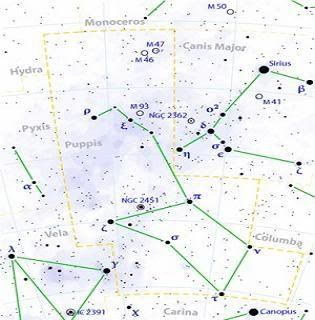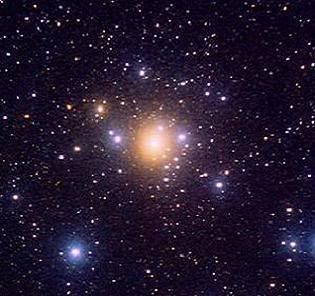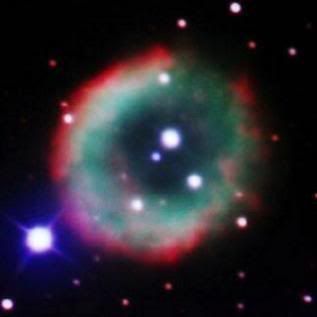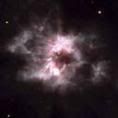Post by glactus on Feb 17, 2008 6:14:32 GMT

Puppis is the largest of four parts which make the ancient constellation Argo Navis, the ship of the Argonauts. When Argo Navis was split no reassignment of the star labels took place so that puppis lacks stars labelled alpha alpha, beta or gamma. The Milky Way runs through this part of the sky making Puppis an interesting region for observations. Many rich star fields can be found.
Notable stars:
Zeta pupp
Zeta Puppis, an extremely blue super giant, also has traditional names Naos ("ship"), as well as Suhail Hadar, "bright star of the ground" in Arabic. It's spectral class is O5Ia, making this an exceptionally hot star, and one of the sky's few naked eye class O stars.Visually, it is 21,000 times more powerful than the Sun. Distance from Earth is 1,400 light years and magnitude is 2.25.
L2puppis
L2 Puppis is commonly an example of a starting variable star for new observers. This deep red variable is always visible to the naked-eye. At a distance of 200 light years, this red giant star shines at a luminosity that is somewhere between 1500 and 2400 times that of our Sun. Magnitude varies from 3.4 to 6.2.
pi Pupp
Pi Puppis is a star that is occasionally called by the traditional name Ahadi, meaning "Having Much Promise". Orange in colour, this class K (K3) supergiant lies some 925 light years away and shines with the light of 19,200 Sun. Distance from Earth is 1,090 light years.
Xi Puppis
Xi Puppis also has the traditional name Asmidiske. This star also has a 13th magnitude companion at an apparent distance of 5".1, while it may also be a spectroscopic binary. Distance from Earth is 1,350 light years and magnitude is 3.34.
Notable objects:

NGC 2440
NGC 2440 is a planetary nebula ejected by a dying star, but it has a much more chaotic structure than NGC 2346. The central star of NGC 2440 is one of the hottest known, with a surface temperature near 200,000 degrees Celsius. The nebula is also rich in clouds of dust, some of which form long, dark streaks pointing away from the central star. Distance from Earth is about 4,000 light years, and magnitude

NGC 2451
NGC 2451 consists of 40 stars, the brightest of which (c Puppis) is a yellowish giant of magnitude 3.6, and the hottest of which is of spectral type B8. Its age was estimated at 36 million years, and it is receding from us at 26 km/sec. At only about 850 light years, this cluster is quite close to us.

NGC 2467
THis image shows the area surrounding the stellar cluster NGC 2467. With an age of a few million years at most, it is a very active stellar nursery, where new stars are born continuously from large clouds of dust and gas. The bright star at the centre of the largest pink region on the bottom of the image is HD 64315, a massive young star that is helping shaping the structure of the whole nebular region.

NGC 2438
NGC 2438 is a planetary nebula discovered by William Herschel in 1786. Visually, NGC 2438 seems to be within the confines of the open cluster M46 but in reality it is closer to us than the cluster making this a coincidental line of sight alignment. The central star of this planetary nebula has a magnitude of 17.7. Distance from earth is 2,900 light years

NGC 2440
credits:
Puppis map: Wikipedia
en.wikipedia.org/wiki/Puppis
image: NGC 2440: omega filters
www.omegafilters.com/index.php?page=omegatext/tech_astro_planetary
image: NGC 2451: messier obspm
messier.obspm.fr/xtra/ngc/n2451.html
image: NGC 2467: pcug.org
members.pcug.org.au/~stevec/ngc2467_ST10.htm
image: NGC 2438:seds.org
seds.org/messier/xtra/ngc/n2438.html


